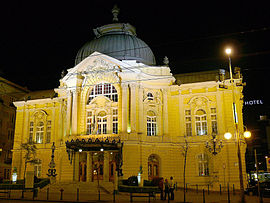- Comedy Theatre of Budapest
-
Comedy Theatre of Budapest 
Address Szent István Street 14 Location Budapest, Pest county, Hungary Type Theatre Built 1896 Opened 1896 Capacity 1000 Website Vígszínház The Comedy Theatre of Budapest (natively Vígszínház) is a theatre in Budapest. Starting in the turn of the 19th and 20th century as an opposition to the conservative National Theatre, it became a pioneer institution of Hungarian drama, and one of the oldest theatres still in operation.
Contents
The building
The Vígszínház was designed by architects Ferdinand Fellner and Hermann Helmer who worked on over 47 state-of-the-art theatre buildings around Europe. Its construction was financed by the tripartite ownership consisting of Count István Keglevich, the writer Ferenc Szécsi, and local businessman Gábor Faludi. I The destined area was a swampland before, but in the next few years it developed into the bourgeois Lipótváros district. The construction started in 1895 and lasted for one year, finishing in 1 May 1896. With 3 main tracts: the stage, including the flies; the lower seating tract; and the entry hall; the building exemplifies late historicism, featuring large sizes, an elevated driveway and baroque decorations, often using golden coloring. As a distinct feature from contemporary theatres, the Vígszínház featured three rows of box seats, large corridors and public areas supported by several wide stairs to answer the call of rising social life in the rapidly developing Budapest.
History
Mór Ditrói was the first director, coming from Kolozsvár (today Cluj-Napoca). He also brought his company of young actors, who were unknown to the Budapest audience at the time. They quickly created a unique and modern repertoire differing from the era's classical theatre, that featured both French comedies, contemporary Hungarian (starting the career of Ferenc Molnár, Sándor Bródy, or Jenő Heltai), and foreign (like from Irwine Shaw, Bertold Brecht, Anton Chekhov) dramas. The Vígszínház provided starting ground and home for several of the biggest names of the theatrical world from the turn of the century, like Gyula Csortos, Lili Darvas, Lili Muráti, Artur Somlay, Klári Tolnay or Gyula Kabos.
In the last days of World War II, Jan 1 1945 the theatre was hit by bombshells, so the company moved to the Radius Movie Theatre in the Nagymező Street. The repairs began under the supervision of Oszkár Kaufmann. Along with other similar artistic institution, Vígszínház was nationalized in 1949 (before this time, it operated as a private theatre). It reopened in 1951 under the name Theatre of the People's Army. Regaining its original name in 1960, Vígszínház became the main center of contemporary drama again, showing plays from Hungarian authors like Gábor Thurzó, Gyula Illyés, István Örkény, or classical 20th century authors like Arthur Miller or Friedrich Dürrenmatt . In 1973 they premiered the popular Képzelt Riport egy Amerikai Pop-fesztiválról (An Imaginary Report on an American Pop Festival), resulting in several other musical productions under the supervision of Gábor Presser. The building underwent significant repairs in 1994.
With an average of 350.000 tickets sold each year, Vígszínház is still one of the most successful theatrical venues in Budapest.
Pesti Színház
Pesti Színház opened in 1967 as the chamber theatre of the Vígszínház. With 530 seats it operates in the Váci Street.
External links
- Official home page of the Comedy Theatre
- The history of the theatre by Emese Patkós (PDF file downloadable from the page)
Sources
- [1] - Comedy Theatre in the Hungarian Theatrical Lexicon (György, Székely. Magyar Színházművészeti Lexikon. Budapest: Akadémiai Kiadó, 1994. ISBN 9789630566353), freely available on mek.oszk.hu
- pestiszinhaz.hu article - History of the theatre on the official page
Categories:- Buildings and structures in Budapest
- Culture in Budapest
- Buildings and structures completed in 1896
- Theatres in Hungary
Wikimedia Foundation. 2010.

